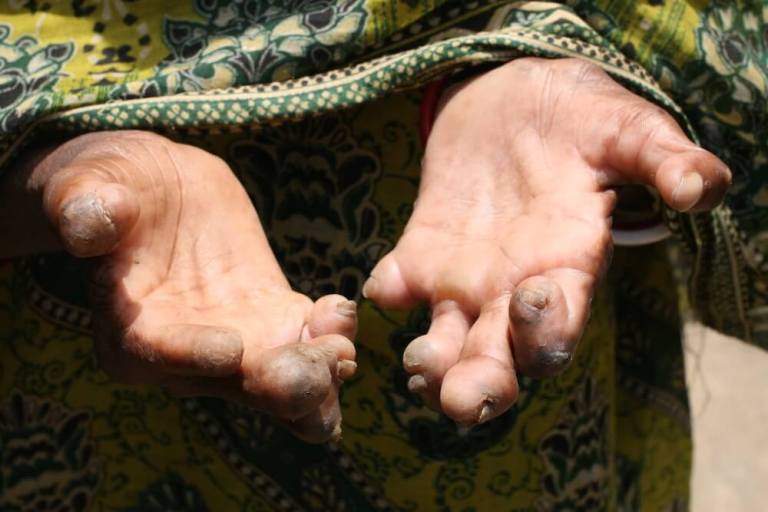ABOUT HANSEN DISEASE

Hansen disease
Hansen disease is the chronic infectious disease that Mycobacteriumleprae (Mycobacteriumleprae) violates mainly skin and nerve.It was gradually clarified after a Norwegian doctor, Armauer Hansen discovered Mycobacteriumleprae in 1873.The growth rate of the Mycobacteriumleprae is very slow, and the latency period is said to be approximately five years.When it develops, peripheral sensory nerves get impaired. The peripheral sensory nerves have a function to feel pain, temperature, etc. in the skin / subcutaneous tissue and convey the sense to the brain.
If the Hansen disease affected person is untreated or without sufficient treatment, it causes after-effect such as limbs and facial deformation or vision disorder.The route of infection has not yet clarified. It is thought that it is infected via splashes from the nose and mouth due to frequent contact with patients who are not cured.
Mycobacteriumleprae which causes Hansen disease is a very weak bacterium, and many people have natural immunity, so it rarely develops even if infected.Also, it will be cured without after-effect even it develops if the treatment is started in early stage.
History of Hansen disease
Hansen disease was mentioned in the Bible and *Nihon Shoki. The disease used to be called **”Tenkei-byo” or “Gobyo“, and it was one of the most feared disease in human history.In the time when there was no treatment, it was considered as “genetic disease”, despite it is an infectious disease. The discrimination against this disease extended to families of Hansen disease patients. There was a great number of Hansen disease patients who were excluded from hometown and wandered around.
After the finding of Mycobacteriumleprae in 1873, segregation policy on Hansen disease was carried out in world wide. At that time, it was though as a terrible infectious disease, even though it rarely develops.As a result, it encouraged discrimination and prejudice against Hansen disease. Patients became isolated and excluded from the society.Although the therapy was clearly found, discrimination and stigma still exist. For this reason, people who are affected by Hansen disease cannot go back their home, and have no option but to stay in sanatoria or a community developed by Hansen disease patients.
Even now they are severely discriminated in education, employment and marriage.
* The second-oldest book of classical Japanese history
**Tenkei-byo is a Japanese term which means destined disease, and Gobyo means an incurable disease caused by his/her bad behavior done in their previous life.

Hansen disease Q&A
Q. Does Hansen disease have to be quarantined?
A. No, there is no need of quarantine.
The pathogenicity of ” Mycobacteriumleprae ” is weak, and it rarely develops even if infected. In Japan, the case which medical worker who works with Hansen disease patients develops Hansen disease has not been confirmed. From this, it can be said that the pathogenesis of “Mycobacteriumleprae” is weak, and no quarantine is needed.
Q. What is the medical treatment for Hansen disease?
A. Multidrug-Therapy (MDT) is used.
In 1943, a medicine for Hansen disease called Promin was developed. Today, various drugs are developed besides Promin, and Hansen disease can be totally cured by early detection and appropriate treatment, “Multidrug Therapy” using these drugs in combination. Now, most of the people living in sanatorium and Hansen disease colony or village are already cured.
Q. How has Hansen disease been treated in Japan?
A. There was a severe quarantine policy in Japan.
In the middle and the early modern period of Japan, those who suffered from Hansen disease were unable to work, and they lived quietly hidden from the society in a room away from the main house. There were also many people called so-called “Furo-rai” who worried about family troubles and wandered all over the country.
Q. How many people get Hansen disease every year in the world?
A. The number of new patients in the world is approximately 218,899 annually (according to 2014 / WHO).
The annual numbers of new Hansen disease patients in major countries are about 12.7 thousand in India, about 3.5 thousand in Brazil, and about 17 thousand in Indonesia.